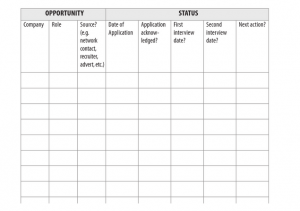Just like any other kind of project, your job search needs structure. Here are some tips on how to manage your « opportunity table » the right way.
À partir du moment où l’on contacte plus d’un employeur, l’idée de colliger les informations reliées à chaque soumission à l’intérieur d’un document (votre « tableau d’opportunités ») tombe sous le sens.
Compiling all the information linked to your different applications in a document (an « opportunity table ») makes sense as soon as you contact more than one company, as Alexandra Bourassa, Employment Counselor explains.
« Job hunters should do more follow-ups on their applications. To facilitate this process, I encourage hunters to create a table in which they put the name of the company they apply at, the target position, and the communication channel they used », she explained during our interview.
One of this process’ interests is to keep important information on hand, knowing in order to know when to re-engage with the company. The counsellor recommends to wait for a working week before following-up on your application.
« In time of a pandemic, hiring processes are slowed down for all companies, that is why it is important for you to remind them of your application. By email or by telephone, remind them of your name, your target position and your interest, adding that you sent your resume and cover letter at that date, hence the table’s value. »
In a book on job hunting, Harry Freedman proposes an « opportunity list » that job hunters can fill with their professional contacts.
For inspiration, here is what the list looks like :

Becoming your services’ salesman
More than an aide-memoire, an opportunity list can become the central tool of your job hunt.
When thinking about it, looking for a job is a lot similar to a salesman’s mission. Instead of selling companies products or punctual services, we contact them to sell our professional services as a permanent employee.
In that mindset, companies become « prospects » with which we need to develop relationships.
From then, we can start using our opportunity list to arrange our « leads » (companies where we kind of want to apply at) and our « prospects » (high potential companies that we have already contacted).
Salesmen highly value the way they « qualify » their leads – they look for the best person to contact in a company – but also making sure they understand their engagement preferences.
What communication channel do they prefer? What pushes them to make decisions? What challenges are they facing in their industries? We can add all of these information in our opportunities table.
We obtain a document containing all the important and pertinent informations on targeted companies, as well as a report on our interactions with them.
Adding one or two selling points to support our applications will give us the « perfect » opportunity table to help us job hunt.
Good luck!




